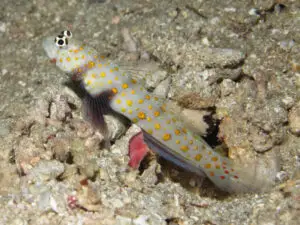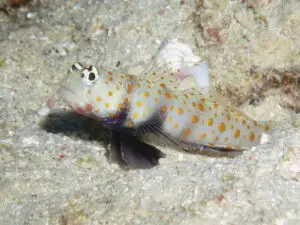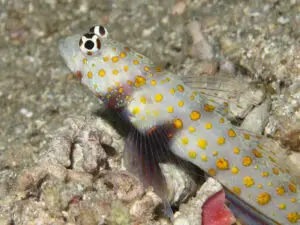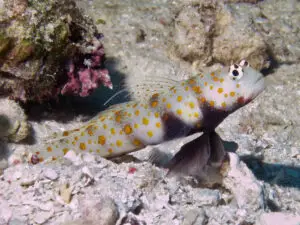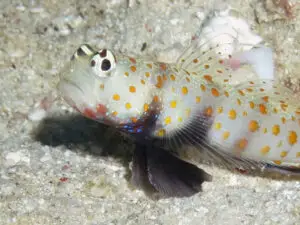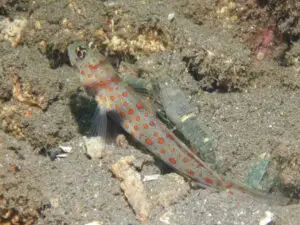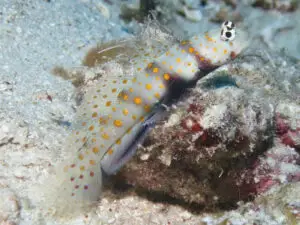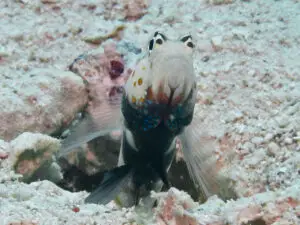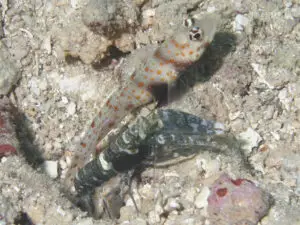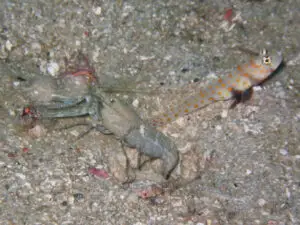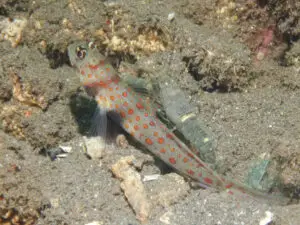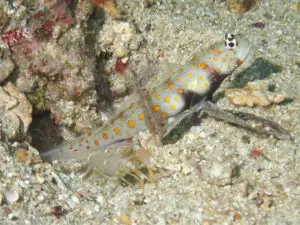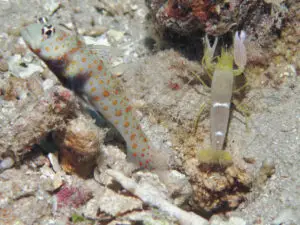Blackchest Shrimpgoby
Amblyeleotris guttata
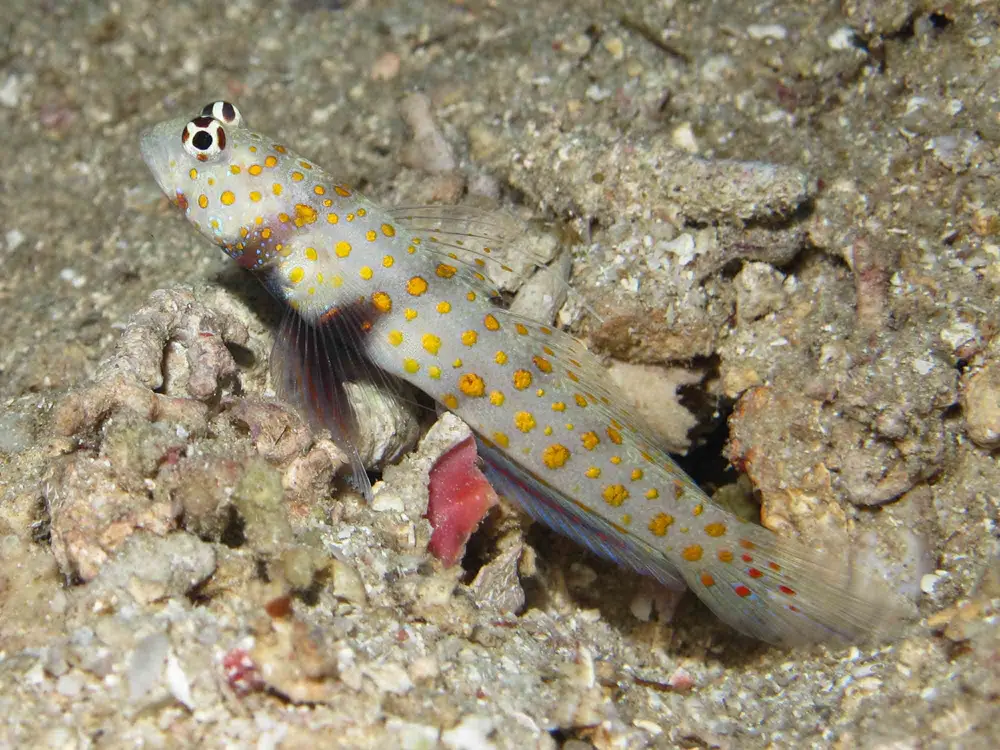
Blackchest Shrimpgoby
Amblyeleotris guttata
(Fowler, 1938)
Description
Body design A medium sized goby, around 11 cm in length, pale ochre in colour, with five rows of golden spots in place of the bars seen in many Amblyeleotris gobies. Between these is a parallel row of smaller golden spots, with still smaller spots between these. At the base of the two anterior rows of spots are conspicuous triangular black patches. This black colour extends under the belly and onto the pelvic fins.
Depending on the amount of pigment the arrangement of the spots into bars may not be obvious and the pattern may look like longitudinally arrayed spots.
Fin design The first dorsal fin is transparent with long rays, the longest being the third. Between the rays are bands of ocellated orange spots. The second dorsal fin is pale ochre with two rows of golden spots and tiny reflective blue spots at the tips of the rays. The pelvic fins are black and the pectoral fins transparent. The caudal fin is transparent with red spots. The base of the anal fin is is ochre decorated with a continuation of the body spot pattern More distally it is blue with a prominent purple stripe in the mid portion.
The parallel slightly diagonal pattern of rows on the body is carried over on to the dorsal fins vertically and horizontally.
Influence of habitat On darker sand the colour of the spots and background of shrimpgobies is intensified. The effect in this species is not marked.
Diagnostic features The most conspicuous feature of this goby is the pair of black patches and the black pelvic fin. This combined with the rows of golden spots distinguish it from all other gobies.
Similar species
Amblyeleotris rhyax and A. fasciata both have the body decorated with golden spots, but this is superimposed on a pattern of red bars.
Natural History
Habitat
Recorded from 4 to 35 metres but usually found in shallower water less than15 metres amongst or near coral reefs. The preferred substrate is clean coarse white sand with lots of shell fragments and coral rubble. This is usually in clean, clear water on moderately protected coral reefs. Here it lives both on sand terraces in the reef and on the sand slope just below the reef or in sand gutters in spur and groove areas of outer reef.
This is a common fish in the Solomon islands where colonies are formed on the sand of reef terraces and under coral rock overhangs. They are not uncommon along the northern Great Barrier reef, where they grow quite large, but they are restricted to the sand closest to the reef wall where burrows are found in ones and twos rather than colonies. They are not found in silty habitats
Behaviour
This is a bold goby that readily becomes habituated to scuba divers barely bothering to move as they swim by.
It props itself up on its pelvic fins on the most prominent small rock near the shared burrow. and remains stationary. This gives it the best view of the surrounding sea floor.
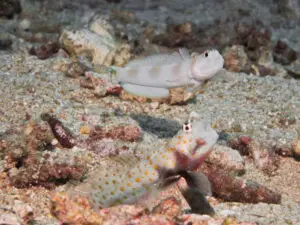
Hovering
A guttata is capable of hovering in the fashion of Vanderhorstia and Stonogobiops shrimpgobies but this is unusual behaviour. This has been recorded by at least one other photographer and is probably display behaviour rather than a feeding technique.
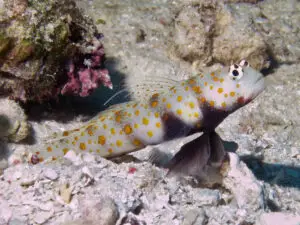
Display behaviour
If the shared burrow is approached too closely, (in this case by a Flag-tailed goby A. yanoi), the response is a territorial display, erecting its fins and opening its mouth wide.
Another display, probably directed at others of its own species, involves progressing along the sea floor in a series of short hops with fins elevated and mouth gaping each time it jumps. (video 25/11)
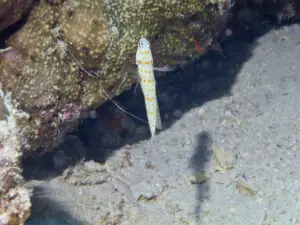
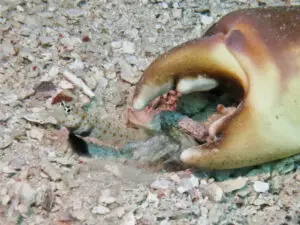
Foraging expeditions
The goby accompanies the shrimp on trips to harvest algae from coral rocks once nearby supplies are used up. In this situation the goby is very exposed and the fastest route to the burrow is obscured.
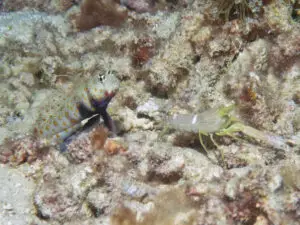
Burrow location
The burrow is located close to coral rubble or the reef structure to gain protection from that direction. On exposed sand, a barrier wall of rubble is constructed or any existing projection (in this case a crab claw) may be used.

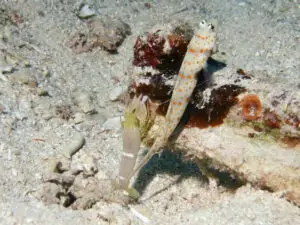
Distribution
Published distribution: Ryukyu Islands and Taiwan Philippines and Indonesia. North west Australia to the southern Great Barrier Reef and Lord Howe Island in the east. New Caledonia, east to Samoa Islands and all of Micronesia.
Our records: Vanuatu, Solomon Islands, Papua New Guinea and Australia: Great Barrier Reef, Lizard Island, Ribbon reefs, Flynn, Michaelmas and Norman reefs, Whitsunday outer reefs, Lady Musgrave lagoon.
Associated Shrimps
5 species
Associated Shrimps (five shrimps)
Primary Partner
Yellow Pyjama Snapping Shrimp, Alpheus ochrostriatus
Frequent Partner
Dark Marbled Snapping Shrimp, Alpheus macellarius
Green Snapping Shrimp, Alpheus species 4
Pale Marbled Snapping Shrimp, Alpheus djiboutensis
Sandy Snapping Shrimp, Alpheus species 12

